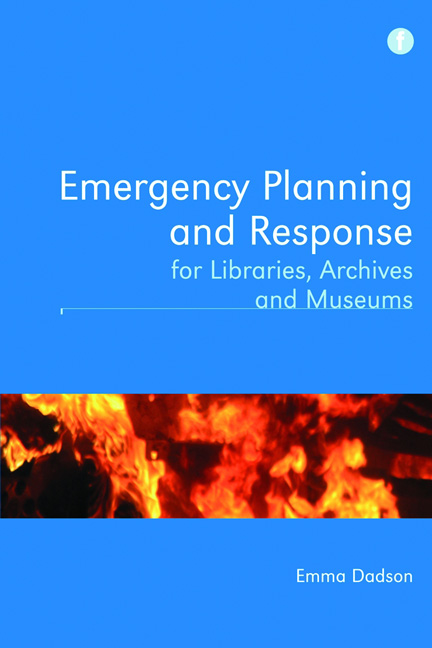Book contents
- Frontmatter
- Contents
- Foreword
- Preface
- Acknowledgements
- 1 Introduction
- 2 Case studies
- 3 Roles and responsibilities
- 4 Incident control
- 5 Planning the recovery operation
- 6 Collections salvage
- 7 Supplementary content
- 8 Dealing with the building
- 9 Business continuity
- 10 Ensuring the plan's efficacy
- 11 Conclusion
- Bibliography and references
- Index
- Frontmatter
- Contents
- Foreword
- Preface
- Acknowledgements
- 1 Introduction
- 2 Case studies
- 3 Roles and responsibilities
- 4 Incident control
- 5 Planning the recovery operation
- 6 Collections salvage
- 7 Supplementary content
- 8 Dealing with the building
- 9 Business continuity
- 10 Ensuring the plan's efficacy
- 11 Conclusion
- Bibliography and references
- Index
Summary
In the aftermath of any major incident, the business or service that the organization provides will be affected and it is essential to consider strategies that might be adopted to mitigate the impact of any incident on service as part of the emergency planning process. Indeed the planning process may provide an opportunity to assess vulnerabilities and improve resilience. The case study of the Brisbane flood affecting the State Library in Queensland in Chapter 2 demonstrated how crucial this can be.
In the commercial sector, this process is known as business continuity, which can be defined as the ability of an organization to respond to incidents so that any disruption caused is minimized to a predetermined acceptable level. The Business Continuity Institute's (BCI's) Good Practice Guidelines define business continuity management as a ‘holistic process that identifies threats to an organisation and the impacts to business operations that those threats, if realized, might cause. It provides a framework for building organisational resilience with the capability for an effective response that safeguards the interests of key stakeholders, reputation, brand and valuecreating activities.’
So does this apply to organizations in the heritage and information services sectors under the definition provided? Clearly a major incident has the capability to impact on brand and reputation and the core mission of an organization. If a higher education library contends with a major incident poorly, consider what reputational damage could be created when stories are published about students unable to complete PhDs and examinations being disrupted. Given internet access and social media, reputational damage could be international. Affected library stock must be treated, but the core mission of the library in a higher education institution is to provide learning support and research facilities for students and academics. Customers and users are also stakeholders and their interests and expectations of continued good quality service must be protected. The international reputation of prominent institutions could be affected, possibly affecting loans programmes and other services.
- Type
- Chapter
- Information
- Publisher: FacetPrint publication year: 2012



